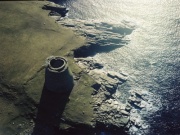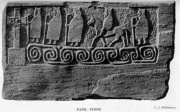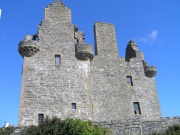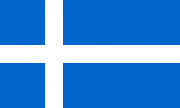Shetland

Shetland is the most northerly island group of Scotland. The "Top of Great Britain" is the home of some 22,000 Shetlanders, and is equally distant from the neighbouring Faroe Islands to the north-west, Norway to the east (with both Lerwick-Thorshavn and Lerwick-Bergen approx. 356km as the crow flies). The most northerly point of the Scottish mainland, Dunnet Head, lies some 210km southwest of Lerwick and Aberdeen, the port of call for the Shetland lifeline ferry service, some 350km to the south.
Geography
Shetland is made up of of over 100 islands, with a central Mainland surrounded by a number of Outer Isles.
History
Shetland has been inhabited for at least 5000 years, probably longer. The first Shetlanders seem pretty clearly to have been farmers rather than hunter-gatherers. More than in most places in Britain, there are traces of the early settlers' houses; since the 1940s dozens of them have been identified throughout the islands, and one or two have been excavated. Striking examples can be seen at Gruting in Sandsting and in the island of Whalsay. The so-called Stanydale "temple" might have been the hall of one of their leaders. The houses are sometimes associated with heel-shaped chambered cairns. Some of the settlement was in the hills as well as at the sea, because the climate at that time was benign.
Iron Age and Brochs
During the deterioration in weather of the Bronze Age (which has little meaning here, since stone continued to be the main type of building and tool-making material in use for thousands of years), Shetlanders moved from inland farms to the shore. The coastal settlement established then has been characteristic of Shetland ever since.
Shetland's Iron Age, on the other hand, was spectacular--not because of iron, but because of a massive increase in building. Warrior Celts came to the islands and built massive forts called brochs, often on the coast, presumably to deter attack by enemies further south. They created our most stunning archaeological monuments. Good examples are the brochs at Mousa, Jarlshof, and Old Scatness. Many brochs have elaborate ramparts; some teeter on the edge of cliffs. (Some modern archaeologists have argued that brochs were big farmhouses, but they do not explain why there were so many of them, and why some are in places entirely unsuitable for agriculture.)
This extraordinary period of Shetland's history lasted from around 200 BC - AD 200. The broch-builders seem to have presided over a very successful society. After AD 200 brochs began to go out of use, or were changed into dwelling houses, presumably because the enemy had ceased to be threatening.
Picts
In AD 297 the Roman praise-orator Eumenius was the first commentator to speak about the Picts, a confederation of tribes in the north of Scotland. They went on to win impressive military victories against southern enemies during the following centuries. Historians argue about when and how effectively the Pictish kingdom extended as far as Shetland. We do know that after AD 700 Christianity arrived in Shetland, introduced by Pictish or Irish missionaries, later called Papar, and sometimes practised by hermits in fairly inaccessible places. There is still a bit of archaeological evidence of Picts here: a few Pictish symbol stones for instance, with more likely to come to light, and the famous St Ninian's Isle treasure, probably buried by a group of Pictish ecclesiastics around AD 800, when Vikings were in the offing.
Viking Raiders
Viking raiders began to come to Shetland around AD 800. They used Shetland as a staging post, sometimes in plundering voyages to the west, and later en route to empty lands like the Faroes and Iceland. They called our islands Hjatland (probably after a tribe called the 'Catti' who lived here, and who had also given their name to Caithness), from which the modern name Shetland derives. (The spelling of the name changed over the centuries. Some examples are Hjaltland - favoured by medieval Icelanders, who thought that Shetland looked like a 'hjalt' or sword-hilt - or Hetland, Hitland or Yetland, Schetland, Zetland or Shetland.)
According to the Historia Norwegie, written by a churchman sometime after 1150, the raiders "stripped" the Picts and the papar 'of their ancient settlements, destroyed them wholly, and subdued the islands to themselves'. The precise date of the Scandinavian settlement of the islands is unclear. The historian Alex Woolf has suggested recently that it might have been postponed till the end of the 9th century, and that Shetland was the chosen home of Vikings repulsed from Ireland. In due course the new Shetlanders became Christians, like the Picts whom they had conquered.
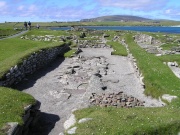
The Earldom of Orkney and the Lordship of Zetland
Eventually Shetland became part of the earldom of Orkney, but how that political unit came into existence is obscure. Some sagas say that in the late 9th century the first king of Norway, Harald Hårfagre took control of Shetland and Orkney and offered them to his his friend Ragnvald Mørejarl along with the title Jarl of Orkney (including Shetland). According to this account Rognvald waived the offer, and gave the islands to his brother Sigurd the Powerful, who thus became the first Jarl of Orkney and Shetland. Other versions differ. Recently Alex Woolf has argued that the earldom of Orkney didn't come into existence until the late 10th century, after a century or so of settlement. Whatever happened, the rulers of Orkney and Shetland were semi-independent princes for a long time.

During the 11th and 12th centuries, when we have better sources, Shetland seems to have been a sort of stepping-off post for claimants to the earldom: Rognvald Brusason, for instance, and Rognvald Kali Kolsson. In other words, Shetland was an integral, albeit rather semi-detached, part of the earldom. Then, in the 1190s, some Shetlanders banded together with Orcadians to launch a campaign against King Sverre of Norway. They were unsuccessful, and in 1195 the king took Shetland from the then Orkney earl, Harald Maddadson. For the next 250 years or so Shetland was usually ruled direct from Norway.
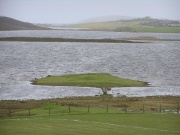
Shetland seems to have been a prosperous enough place during the so-called high middle ages. Powerful landlords had influence here, some of them based in Norway, but they could be kept in check by the local community. Shetland had its own little parliament at Tingwall, in the very centre of the islands, where law cases were adjudicated on, and Norwegian law was promulgated. Shetlanders sent their valuable fish to the Hanseatic kontor in Bergen.
In the mid-fourteenth century, however, there was major change. The Black Death came to Shetland in 1349, and although we don’t have detailed evidence about its impact, it is likely that there was a lot of mortality, as everywhere else. However, during the economic depressions that afflicted Norway in the late middle ages, Shetland, as a fish- rather than a grain-producing country, probably did relatively well - more so than Orkney, for instance.
In 1379 Henry Sinclair, a landlord from Roslin in Scotland, became earl of Orkney, and although he probably didn’t have direct control in Shetland, there is evidence that his family established various kinds of influence here. For instance, his nephew got a feudal grant of Shetland for his lifetime in 1418. At the same time, churchmen were coming to Shetland from Scotland. Very gradually the islands’ links with Scandinavia were beginning to wane.
Hanseatic Trade
Meanwhile, a new relationship between Shetland and the outside world was developing. From about 1450 merchants in North Germany began to ignore the rules of the Hanseatic League, and to sail direct to Shetland to trade with the inhabitants for fish. They brought essential and luxury goods in return. During the next 250 years these merchants took over most of Shetland’s fish export trade. They based themselves at anchorages around the islands, travelling here every year in spring and returning at the end of the summer, and became indispensable components of the local economy and society. Local officials made sure that the Germans were assigned to ports and regulated their prices.

In 1397 Norway had become part of the Kalmar Union with Denmark and Sweden. In the long term that meant that Norway became less and less independent. When the daughter of King Christian I of Norway, Denmark, and Sweden, became betrothed to James III of Scotland in 1468, King Christian was unable to pay the dowry. Without the knowledge of his Norwegian council he pawned Orkney for 50,000 florins of the Rhine on 8th September 1468; and on 28th May 1469 he pawned Shetland for another 8,000 florins. Although several Danish monarchs tried to redeem the islands, between 1549-1667, their attempts (some of them not very serious) failed. On 20 February 1472 James III annexed Shetland and Orkney to the Scottish crown, and there we have remained since.
During the next ninety years or so not a great deal changed in the islands. Servants of the Scottish kings collected rents and taxes and administered justice here, just as servants of the Norwegian crown had done. More Scots came to Shetland, as merchants and adventurers; sometimes they married Shetland heiresses. But the legal system and other institutions remained much as they had been for hundreds of years.
The Cruel Lairds
From the 1560s onwards, however, the pace of change quickened. The Scottish Reformation brought a new breed of greedy clergymen; and in 1564 Mary Queen of Scots gave her half-brother Robert Stewart, a man of appalling character, a lease of Shetland and Orkney. Robert appointed his own half-brother, Laurence Bruce of Cultmalindie in Perthshire, as chief foud or magistrate of Shetland. Bruce created havoc. He ignored the Shetlanders’ laws and institutions, increased taxation and altered weights and measures, and imported rowdy and violent servants.
In February 1577 700 male Shetlanders travelled to the old parliament site at Tingwall to complain to royal commissioners from Edinburgh about Bruce’s oppressions. Bruce was removed, briefly. He returned shortly afterwards, this time as Robert’s sheriff; but his wings had been clipped to some extent. Robert Stewart became earl of Orkney in 1581, consolidating his family's control in the islands.
Earl Patrick Stewart replaced his father in the islands in 1593. He was more careful than Robert to conciliate the Shetlanders; he used the old Norwegian lawbook in local courts, and often appointed Shetlanders as officials. Shetland was a relatively prosperous place under his rule. The German merchants continued to provide a solid basis for the islands’ economy, and Dutch fishermen took much-needed cash here. But Patrick fell foul of Laurence Bruce, and other landlords who were jostling for power in Shetland. When Patrick died – he was guillotined in Edinburgh in 1615, for treason – the landlords took control.
The seventeenth century in Shetland was one long crisis. For much of the time the landowners argued with each other, sometimes violently. As long as the German merchants came, the economy limped on. But in the 1680s and 1690s a series of things happened to discourage them. Privateers swarmed around the North Sea, and sometimes pounced on the Germans and their property. The climate deteriorated, smallpox afflicted the Shetlanders, and, thus weakened, they weren’t attractive enough customers for the Germans any more. The Act of Union, which discouraged trade with foreigners, was the last straw. The last of the German merchants had disappeared by 1712, leaving the Shetland economy in a state of collapse.
A new period now opened in Shetland’s history. Several local landlords stepped into the trade that the German merchants had abandoned. They fitted out ships to take Shetland fish to the continent. To make their business more efficient, they made it a condition of tenure for their tenants to fish for them. There was a sometimes written, usually unwritten understanding between tenant and merchant-laird that if the tenant sold his fish to anyone else, he was in danger of being ejected from his house. As time passed the merchant-lairds bought up more and more land, and thus acquired large numbers of fishing tenants. Gradually most of the population fell into debt, because the fishing tenants had to get their goods at the merchant-lairds' shops. They exchanged their fish for shop-goods: a relationship called 'truck'. Shetland became a cashless society.
As Adam Smith wrote in 1774: ‘The sea in the neighbourhood of the islands of Shetland is more than commonly abundant in fish, which makes a great part of the subsistence of their inhabitants. But in order to profit by the produce of the water, they must have habitation upon the neighbouring land. The rent of the landlord is in proportion, not to what the farmer can make by the land, but to what he can make both by the land and the water. It is partly paid in sea-fish; and one of the very few instances in which rent makes a part of the price of that commodity is to be found in that country.’
For most of the time up to the second half of the eighteenth century, Shetlanders had been isolated from the outside world. One proof of that is the havoc that smallpox caused when it got a foothold, as it did in 1700, 1720, 1740 and 1760: Shetlanders had no immunity from it, because of their isolation, and adults died as well as children. (It wasn't until the late 18th century that smallpox was got under control, thanks mainly to inoculation.) During the Napoleonic wars, however, thousands of Shetland men had to join the navy, many because they were ‘pressed’ (snatched by naval officers). If they survived, they saw the world. One of the few benefits of this situation, for Shetland, was that the seamen frequently sent cash home to their families. More and more money appeared in the formerly cashless society.
Growth of Lerwick
Lerwick, previously a small village, began to grow, its economy stimulated by the presence of soldiers at Fort Charlotte. A merchant class developed in the town, and some of the traders were willing to buy fish from fishermen in the rural areas. For a while the rules of fishing tenure were relaxed, and there was little that the landlords could do about it. After the wars the Shetland economy diversified; some of the merchants fitted out ships to prosecute cod fishing, first of all around Shetland and later around the Faroe Islands. Others were agents for whaling operations based in Scotland and England. Dozens of Shetland men signed up for whaling trips, and thus escaped the tenurial restrictions at home.
It was a time when Shetlanders began to get interested in ideas from elsewhere. After the Napoleonic wars nonconformist sects challenged the authority of the Church of Scotland, sometimes introduced by local people. Methodism was especially successful, imported by a Shetlander and sustained by visiting missionaries, mainly from England. By this time the Norn language of the islands had died, and Shetlanders were speaking a Scots dialect. For a moment it looked as if Shetland was developing like any other modern commercial society.
But from the 1830s until the 1870s Shetland reverted to its old state. Famines in the thirties made it necessary for the fishers to get credit from lairds, or merchants nominated by them, once again. From the 1840s onwards hosiery merchants in Lerwick used truck in their transactions with knitters. In 1871-2 two royal commissions heard evidence about truck in Shetland, and concluded that it was entrenched in every part of the islands, and almost every part of the economy.
The Clearings
A few landowners tried sheep-farming, taking advantage of improved transport links between Shetland and the mainland. They evicted many tenants in the process. During the period 1860-1880 more than 2000 people left the islands: a large number went to North America and Australasia. But at home most of the merchant-lairds still preferred to have a large tenantry who were bound to fish. The population of Shetland peaked in the 1860s, at about 32,000. The merchant-landlords patted themselves on the back, and argued that no other economic system was feasible in Shetland.
They were wrong. Two things happened, in quick succession, to change the Shetland scene for ever. Around 1880 the booming Scottish herring fishery began to make its influence felt here. It was a phenomenal success. The lairds leased their property to businessmen for herring stations; fishermen (men and women) flocked to the new fishery, and earned cash, sometimes for the first time in their lives. The bonds between landlords and fishermen disappeared almost overnight, and truck disappeared. An act of parliament in 1887 abolished truck in the hosiery industry as well - although merchants usually flouted it up to the 1930s.
In 1886 the British government enacted crofting legislation which made it virtually impossible for the landlords to evict their tenants. The newly formed Crofters Commission came to Shetland in 1889 and 1892, slashed rents and discomfited the landlords. There was crofter agitation in some areas. It was a time of emancipation. Shetland’s centuries-old landlord-controlled autonomy had been abolished, and the Shetlanders rejoiced.
Local Political Developments
Most of the period from 1880 until the first world war was joyful and prosperous for the islanders. It was a time when Shetlanders, stimulated by the recent Education Act (1872), began to write about the islands, in verse and occasionally in novels, sometimes in dialect. A lively newspaper press, the Shetland Times (1872-) and the Shetland News (1885-1963) arrived. Many more male Shetlanders got the vote - most of them cast it for the Liberal party, and still do - and there was a relatively democratic form of local government from 1890. Lerwick got a fine new town hall, and other civic buildings gradually followed.

In the early 20th century herring remained the mainstay of the Shetland fishing industry, with Herring Stations in Lerwick Harbour, Baltasound, Sandwick and the like, curing and barreling herring for export. (By that time the haaf and cod fisheries and the Greenland whaling had dwindled away to nothing.) The biggest peak in herring landings came in 1905 when over 113,000 tons were landed, including over 44,000 tons at Baltasound. This peak in the fishery was in no small way linked to the introduction of steam drifters in 1900, although the first Shetland registered steam drifter didn't appear until 1906. By that time the herring fishery was at the very beginning of a slow decline again, probably unnoticed at the time.
The Great War and Inter-War Years
During the First World War, the fishery fell to as little as 4,000 tons per year, creating a catastrophe for the Shetland community. Markets in central Europe were lost for ever. Although it recovered during the 1920's, the herring fishery was no longer the great industry of Shetland.
During the period 1919-39 the islands fell into severe economic depression, which (with the exception of a blip during the Second World War) continued until the 1960s. In 1961 the population of the islands was 17,500 - not much higher than it had been in the mid 18th century, and not much more than half of what it had been in the 1860s. More and more people moved to Lerwick, if they didn't leave the islands altogether. It was a bleak time.
Post War Development
But in the fifties and sixties a group of Shetlanders, under the umbrella of the Shetland Development Association, later the Council of Social Service, using the New Shetlander magazine as its mouthpiece, fought to improve the economic situation in the islands. To a large extent they were successful; by the late sixties Shetland's fishing, textiles and agriculture were in good heart.
Black Gold
Then came oil, from 1972 onwards. The construction of the huge Sullom Voe oil terminal saw a major influx of people from the south. Many of them stayed in the islands and settled with their families all over Shetland, and thus helped to keep our villages alive. New jobs were created inside the terminal and outside--as at Lerwick harbour--as well. Money from the Oil Reserve Fund put the council into a unique position to build up a wide range of high quality infrastructure to meet the demands of a modern society, from schools to leisure centres, from new museums to library services, from community housing projects to roads and ferry or airport terminals.
The fishing industry still plays a major role in Shetland's economic life although more recent developments into fish farming and modern methods of fish processing have changed the scene drastically. In addition to a modern fleet and fish processing companies, Shetland hosts the NAFC Marine Centre, Scotland's leading professional training and research centre for the fishing industry.
Improved ferry services to and from the Scottish mainland and regular air services to all important Scottish destinations lead to reduced travelling times and more travelling comfort for both Shetlanders and visitors. They promoted Shetland's tourism to another key industry creating important additional incomes from a wide range of public services to private businesses.
AIS equipped vessels in Shetland waters can be viewed in real time here
